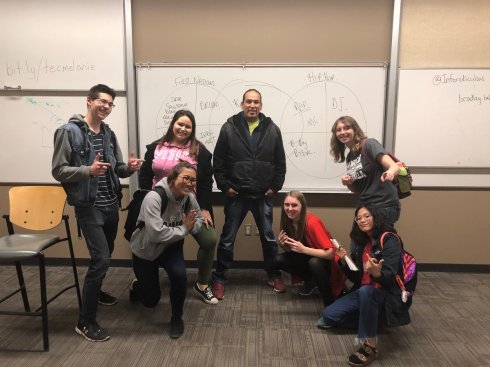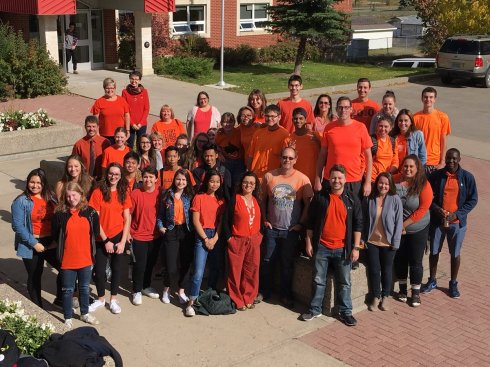This weekend I had the privilege of taking eight students to the UR S.T.A.R.S. Treaty Ed Camp. It was a fantastic event, filled with amazing sessions. This day is not only beneficial to myself as an educator, learning new things to apply to my own practice, but is beneficial for my students who we amazing enough to attend a conference on their weekend! We had one grade nine, two grade tens, and three grade twelves attend the event. At the beginning of the day I explained to them how they could utilize social media throughout the day, and showed them how to use the #TreatyEdCamp twitter hashtag. Throughout the day they were tweeting what they learned, and had amazing things to say. I was incredible impressed with their leadership, confidence, independence, and thirst for knowledge throughout the day. At the end of each session they would rush to find me, and tell me all that they learned. They took pages and pages of notes, and the conversation on the drive home was the most engaging discussion I have had about Treaty Education in a long time.

Treaty 4 students with keynote speaker Erica Violet Lee
I wanted to be able to share some of the key themes that I learned throughout the day. One of the things that stood out most to me, as it came up from nearly every presenter I listened to, was language. Since taking my Cree class, I have noticed more and more, how much the topic of revitalizing Indigenous language comes up in talks about reconciliation. Language is a carrier for culture, and it is so crucial that we protect it! The beginning of the keynote speech, by Erica Violet Lee, began with a greeting in Cree. I was extremely excited when she began, because I recognized that I understood every single thing that she had said! This was the first time that I have ever actually understood another language (aside from bits and pieces of French) when it was actually being spoken to me. Language has been lost in my family for numerous generations, so I felt very empowered being able to understand what she was saying, and confident that I myself could deliver the same greeting. I clearly have a long way to go from here, but you have to start somewhere!
The keynote address was packed full of information and thought provoking statements. Lee often name dropped different authors, and I found myself adding books to my amazon cart as we went, like #IndianLovePoems by Tenille K. Campbell, and Nationhood Interrupted: Revitalizing nêhiyaw Legal Systems by Sylvia McAdams. She stated that it is “important that we are using the word genocide, because they don’t want to go there.” She talked about death, and mourning of that death, and being able to mourn without being weak. A powerful thing that she discussed was the idea of archives, and how the person who decides what goes in the archives is literally defining what knowledge is. She urged us to be conscious of this, as we are making our course outlines and deciding what content to teach, because we are also defining that knowledge. She shared stories of her time in high school, and the work she did to decolonize the racist mascot that she was told to identify with for so many years. So many powerful things were said during this keynote address, which will be available to watch through UR S.T.A.R.S. online!
“I wish I didn’t have to talk about colonialism everyday – What could we do if we weren’t always defending our humanity” – Erica Violet Lee
The first session I attended was Interfacing Indigenous Knowledge and Mathematics Education Through Math Fairs lead by Shana Graham. She discussed different ways we can assess mathematics that is more culturally broad. She discussed the idea that 1 + 1 = 2 is a Western way of thinking. When thinking about mathematics, the western viewpoint is that there is a right answer, and only that answer can be correct. She explained that this representation is not universally correct. She used an example of two paper clips. If you add one paper clip and one paper clip you end up with two paper clips. We could all agree that the logic made sense. She then grabbed a container of play dough, and had one ball of play dough and added one ball of play dough, and when she put them together she had… one ball of play dough! In that perspective 1 + 1 = 0. She challenged us to think that the way we are teaching mathematics is limiting our student’s creativity. She also shared a resource on math fairs, with examples of what she has done in her university classes.

Treaty 4 students share their work from their session Colonialism on Canvas.
The second session I attended was Smudging in Schools by Jeff Cappo. He shared knowledge on smudging, the importance of smudging in schools, and then we participated in a smudge. He spoke on how important it is to make a connection with our Indigenous youth, and to make smudging more normalized. He explained about how smudging takes the negative out of you and leaves it with positive. I participated in this session with one of my student’s and we both discussed how smudging makes you feel grounded. Cappo spoke about the reasons why we smudge, and how we have to be doing it inside the schools… not outside, because that leaves the wrong message. Smudging outside is saying that it is not something that is inclusive to the school, and does not have the spirit of reconciliation.
“The primary objective of smudging in schools are aimed at:
- Promotion of health and balanced lifestyles of those we are with
- Creating cultural awareness and aiding in the process of gaining a sense of cultural identity”
– Jeff Cappo
The third session I participated in was a session I have done before, but still learned new things when I attended. I listened to Edward Doolittle speak on the Peach, Stone, Bowl game. I was urged to attend this session because one of my grade ten students wanted to learn the game so that she could teach our math class this semester! I was excited for this to happen, and figured I could use a refresher on how the game works. Doolittle spent a great deal of time speaking about the intent of the game and the importance of language. He spoke to us in Mohawk, and explained that we do this best with what we have available. He spoke on the creation story, and how all comes from that. Last year he shared the Iroquois Creation story, and told us that before we begin we have to remember that all comes from here. During this session he explained a cultural perspective on math from Alan Bishop that focus’ on 6 areas: measuring, counting, locating, designing, playing and explaining. This was a common theme, as it came up in the previous session on math I attended as well. Doolittle, like Graham, also discussed how our perspectives need to change. The game he explained was about probability, and he used this idea to show that our world is so much more complex than the theory that mathematics over simplifies.
“This was the best that I could do – people are scared to do Indigenous teaching in their classroom because they are scared they won’t do it right – that shouldn’t stop us from trying” – Edward Doolittle
The last session of the day was spent with Info Red, aka Brad Bellegarde. He shared his session Rap as the New Buffalo. This was a fantastic way to end the day because he was very funny and we were all excited to hear him rap. Again the topic of language came up, as he began listing the five dialects we have in Treaty 4. He greeted us in numerous languages and showed us how easy it is to be more inclusive with our language.

Treaty 4 students with Brad Bellegarde
All together the day left me filling full – my mind was full of new information, my heart was full watching my student’s passion, my soul was full because I felt like I was truly participating in what I was passionate about, and my stomach was full because we made a quick stop at the Bannock House on the way home for Indian Tacos and Maple Bacon Moose Ears. Days like this are so incredibly important for all involved, and I strongly suggest participating in future years. If you would like to learn more about what happened at the Treaty Ed Camp you can follow the hashtag on twitter for more snippets of what was learned!
“It is precisely because education was the primary tool of oppression of Aboriginal people, and mis-education of all Canadians, that we have concluded that education holds the key to reconciliation” – Justice Murray Sinclair
Tags: anti-oppressive, Cree, decolonization, edchat, education, idlenomore, Language, ReconciliACTION, Reconciliation, Treaty 4, TreatyEdCamp, Truth and Reconciliation Commission, University of Regina, UR STARS












